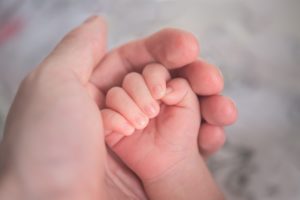Imaginary Child
by Janet Gool

Photo by Hu Chen
The doctor, her hair tied back in a ponytail, a miniature teddy bear hanging from her stethoscope, looked too young to pronounce our fate. She peered at the baby’s face, unclenched her tiny fists, and examined the palms of her hands.
* * *
Our first two children arrived as if we had ordered them from a mail order catalogue. Our oldest was born two weeks after my husband, Yochanan, and I celebrated our first wedding anniversary. Following my mother’s wise advice, we waited until she was out of diapers before adding her brother. The third child, however, tarried.
I made a decision a few months before my thirty-ninth birthday: if I was not pregnant within the year, I would stop trying. I was thirty years old when I got married, and I had two bright, healthy children. Surely this sufficed. Six months later I called my husband on the phone, giggling.
“What’s so funny?” Yochanan asked.
“Now I understand why the biblical matriarch Sarah laughed when she found out she was carrying Isaac at the age of ninety,” I told him. “It’s funny to be pregnant at this age.”
My happiness was tempered by my knowledge that being pregnant at forty carried risks. Like all women, my ova had been with me since I was formed in my mother’s womb, and ova do not improve with age. The older the ovum, the greater the risk of having a baby with Down’s syndrome, a genetic mutation that results in cognitive and physical disabilities.
As a nurse, I also knew that the only way to know conclusively if the baby had Down’s syndrome was by performing amniocentesis, a test that requires inserting a needle through the wall of the mother’s abdomen into the uterus, extracting some of the amniotic fluid in which the fetus floats. This fluid is then analyzed in a process which takes about two weeks. Since amniocentesis can only be done in the sixteenth or seventeenth week of pregnancy, a woman is close to her twentieth week by the time she knows the result of the test, at which point the abortion is much more physically and emotionally traumatic.
The nurse at the prenatal clinic was enthusiastic about my pregnancy.
“Think how young you’ll feel, pushing a baby carriage through town. And what a lucky baby it will be to have parents with so much experience and wisdom and a loving big sister and brother.”
At the same time, the nurse cautioned me regarding the risks associated with my age. She recommended we make an appointment for genetic counseling at Hadassah Hospital.
My blood pressure climbed dangerously high during the weeks I waited for the appointment. The doctor insisted I stay home on bed rest. I began to wonder if I could carry the pregnancy to term with my blood pressure so high, so early on. And I knew what was worrying me.
I had learned about the different types of abortion from my training as a nurse. I remembered that when an abortion is performed in the second trimester, the pregnancy is too advanced for a simple dilation and curettage. Instead, saline is injected into the uterus, causing the mother to go into labor and deliver a dead fetus. That’s an extreme procedure, I remember thinking when our instructor described it in class. It should be reserved for extreme circumstances. And that is the procedure that would be available to me if, after performing amniocentesis at the seventeenth week and waiting two weeks for the results, I decided I did not want a child with Down’s syndrome. These thoughts had stayed with me since that time.
* * *
I arrived at the clinic hoping that the counselor, a nurse like me, could help me organize those thoughts and feelings into something coherent that I could share with the people around me. She, however, had a different agenda.
Yochanan and I watched a short film together. It described Down’s syndrome, how a child with Down’s developed, and what the family could expect. After watching the film, we returned to the counselor.
“In our experience,” she said, “raising a child with Down’s syndrome can be very difficult. I’m sure you realize this after watching the film.” She advised scheduling the amniocentesis and an abortion, depending on the results.
I had hoped the counselor would help me articulate the feelings that lay knotted in my gut. Instead, she made assumptions that seemed facile and superficial. I began to argue with her.
“We had neighbors when I was growing up whose third child, Betty Joe, had Down’s syndrome. She didn’t ruin their lives. In fact, they had a fourth child seven years later. Their oldest daughter, Kathy, went on to teach special education.”
“They must have been saints,” said the counselor, but I didn’t think so. The Labukases were great neighbors and wonderful people, but they were ordinary human beings. The father, Pete Sr., was a regular member of a neighborhood poker game, along with my father. Their mother, a school secretary, grew tomatoes.
I had thought a lot about the Labukas family since I learned that I was pregnant. Betty Joe was my age. While she was not a central player in my childhood, she was a constant one. Long before recycling became politically correct, Betty Joe traversed the neighborhood pulling a red wagon behind her. She collected used newspapers from all the neighbors, which were recycled. The proceeds, I was told, went to benefit her school. Summer evenings, when the neighborhood children gathered to collect fireflies, Betty Joe was there with us. Although childhood memories may be selective, I could not recall any incidents of Betty Joe being mistreated by the children in our neighborhood.
Betty Joe, with her warm and sunny personality, helped shape the way I view people with special needs. When I thought about children with Down’s syndrome, I didn’t think about disappointment or burden, I thought about red wagons and fireflies on summer nights.
We left the genetic counselor and sat down for a cup of coffee to discuss what she had told us.
“What she said made sense,” Yochanan said. “What do you think?”
“Tell me,” I said, “if everything is okay with the baby, but then it has some sort of mishap during birth, let’s say a cord around the neck and it suffers brain damage, would you suffocate it in its crib?”
Yochanan looked shocked.
“I had no idea you felt like this. Why didn’t you say something sooner? If you feel so strongly, then we won’t do the tests. Anyway, I feel in my heart that everything is going to be okay.”
During the drive home, he had more to say.
“I don’t get it. You’re such a feminist. Whenever the subject of abortion comes up, you’ve always been in favor of it. What happened?”
“I’m still in favor of legal abortion,” I told him. “It just isn’t an option for me now.”
The doctor at the prenatal clinic expressed dismay when I told her that I had decided to forego genetic testing.
“You don’t look like a religious fanatic,” she said, looking me up and down. The clinic nurse, on the other hand, was delighted. Surely God would reward me with a healthy baby, she said. She didn’t look like a religious fanatic either. All three of us were happy that my blood pressure had stabilized.
As my pregnancy progressed, I began to make mental preparation for the birth of a child with Down’s syndrome, creating an imaginary child. If anyone offered me sympathy on the birth of a disabled child, I would immediately say that my husband and I were delighted with our baby. I’d send out expensive, embossed birth announcements to all of our family and friends in the United States. If it were a boy, I’d plan an extravagant circumcision ceremony, complete with live music and photographer. And if it were a girl, I’d have an equally large party, minus the snip. Lastly, I would give up my position as a psychiatric nurse and find a job that was less emotionally demanding.
I kept all these plans to myself. I didn’t share them with Yochanan, the clinic staff, or anyone else. It was my private way of strengthening myself, just in case.
About six weeks before my due date, I began to suffer terrible doubts. Why had I insisted on taking the moral high road? Suppose I had a child who was profoundly disabled, not a pleasant, amiable person like Betty Joe? Would my marriage stand up to such pressure? Would I have the emotional and physical stamina to care for a child like that and still care for my other two? Would they resent me, hate me, for neglecting them?
I imagined the alternative. In my mind, I walked through the amniocentesis and the phone call about bad results. I thought about the procedure in the hospital, the saline injected into my belly, the contractions and pushing, the fetus rushed out of the operating room in a stainless-steel bowl. I tried to imagine integrating that experience into my life and, once again, I knew I couldn’t. It would warp me in some terrible way; I could never make peace with myself.
The feeling of doubt left me. There was nothing left but to wait for the birth.
* * *
The doctor who admitted me to the delivery room examined my file and made note of my age.
“You’re forty years old,” he said. “I assume you did the usual genetic testing?”
“No,” I told him.
“That’s all you have to say?” he said, arching his brow.
I nodded. What was the point of reviewing all we had been through these past months?
In retrospect, I understood that I had made my decision in that classroom, years before I met Yochanan, years before I had planned a family. It was a visceral reaction to what I had learned in class, not an intellectual decision arrived at through thought and consideration. This had made it difficult for me to communicate what I felt to the people who had needed to hear me—Yochanan and the nurses and doctors at the genetic counseling clinic.
* * *
The midwife was the first to see the baby we would call Kinneret.
“She looks fine,” she told Yochanan and me, “but just to make sure, have the pediatrician examine her. You can talk to the doctor in the morning. Now try and get some sleep.”
The next morning, the doctor peered at the baby’s face, unclenched her tiny fists, and examined the palms of her hands. I knew she was checking for one of the recognizable physical features of Down’s syndrome: a straight line that runs in a single crease across the palm, rather than the two curving ones that are usually found there. And so, she studied our baby’s palms as if she could read her future there.
“This baby is fine,” she told me. The months of tension and doubt ended with four short words.
